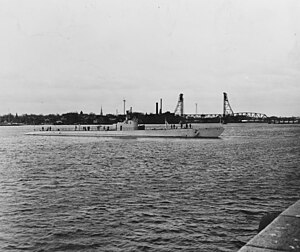| USS Cachalot (SS-170) | |
|---|---|
| Career (United States) | |
| Builder: | Portsmouth Naval Shipyard, Kittery, Maine[1] |
| Laid down: | 21 October 1931[1] |
| Launched: | 19 October 1933[1] |
| Commissioned: | 1 December 1933[1] |
| Decommissioned: | 17 October 1945[1] |
| Struck: | 1 November 1945, reinstated 28 November 1945, stricken again 8 July 1946[1] |
| Fate: | Sold for breaking up, 26 January 1947[1] |
| General characteristics | |
| Type: | V-8 (Cachalot)-class direct-drive diesel and electric submarine[2] |
| Displacement: | 1,110 long ton (1,130 t) surfaced, standard,[3] 1,650 tons (1,680 t) submerged[3] |
| Length: | 271 ft 11 in (82.88 m)[2] |
| Beam: | 24 ft 11 in (7.59 m)[2] |
| Draft: | 16 ft 3 in (4.95 m) maximum[2] |
| Propulsion: |
|
| Speed: | 17 kn (31 km/h) surfaced,[3] 8 kn (15 km/h) submerged,[3] 7 knots (13 km/h) submerged, service, 1939[3] |
| Range: | 6,000 nautical miles (11,000 km) @ 10 kn (19 km/h),[3] 14,000 nmi (26,000 km) @ 10 kn (19 km/h) with fuel in main ballast tanks,[3] 83,290 US gallons (315,300 L) oil fuel[8] |
| Endurance: | 10 hours at 5 kn (9.3 km/h)[3] |
| Test depth: | 250 ft (80 m)[3] |
| Complement: | 6 officers, 39 men (peacetime); 7 officers, 48 men (war)[8] |
| Armament: | 6 × 21 in (533 mm) torpedo tubes (four forward, two aft, 16 torpedoes),[3] 1 × 3 in (76 mm)/50 cal deck gun[3] |
USS Cachalot (SC-4/SS-170), the lead ship of her class and one of the "V-boats", was the only ship of the United States Navy to be named for the sperm whale. Her keel was laid down by the Portsmouth Navy Yard. She was launched on 19 October 1933 as V-8 (SC-4) sponsored by Miss K. D. Kempff, and commissioned on 1 December 1933 with Lieutenant Commander Merril Comstock[9] in command. Cachalot was the first submarine to have the Torpedo Data Computer, Arma Corporation's Mark 1,[10] installed.
Service history[]
Inter-war period[]
After shakedown, further construction, tests, and overhaul, Cachalot sailed for San Diego, California, where on 17 October 1934 she joined the Submarine Force, U.S. Fleet. Operating until 1937 principally on the West Coast, she engaged in fleet problems, torpedo practice, and antisubmarine, tactical, and sound training exercises. She cruised twice to Hawaiian waters and once to the Panama Canal Zone to participate in large-scale fleet exercises.
Cachalot cleared San Diego on 16 June 1937, bound for New London, Connecticut, and duty in experimental torpedo firing for the Newport Torpedo Station, and sound training for the New London Submarine School until 26 October 1937, when she began a lengthy overhaul at New York Navy Yard. A year later, she sailed for participation in a fleet problem, torpedo practice and sound training in the Caribbean Sea and off the Canal Zone, and on 16 June 1939 reported at Pearl Harbor for duty with the Submarine Force and the Scouting Force.
World War II[]
War came to Cachalot as she lay in Pearl Harbor Navy Yard in overhaul. In the Japanese attack on Pearl Harbor of 7 December 1941, one of her men was wounded, but the submarine suffered no damage. Yard work on her was completed at a furious pace, and on 12 January 1942 she sailed on her first war patrol. (Like her sisters, her MAN engines, license-built in the U.S., caused constant headaches, and she was eventually re-engined). After fueling at Midway Island, she conducted a reconnaissance of Wake Island, Eniwetok, Ponape, Truk, Namonuito, and Hall Island, returning to Pearl Harbor on 18 March with vitally needed intelligence of Japanese bases. Her second war patrol, for which she cleared from Midway on 9 June, was conducted off the Japanese home islands, where she damaged an enemy tanker. Returning to Pearl Harbor on 26 July, she cleared on her final war patrol on 23 September penetrating the frigid waters of the Bering Sea in support of the Aleutian Islands operations.
Over age for strenuous war patrols, Cachalot still had a key role to play, acting as training ship for the Submarine School at New London. She served there until 30 June 1945, when she sailed to Philadelphia, Pennsylvania, being decommissioned there on 17 October. She was sold for scrap on 26 January 1947.
Awards[]
Cachalot received three battle stars for her World War II service.
Gallery[]
References[]
- ↑ 1.0 1.1 1.2 1.3 1.4 1.5 1.6 Friedman, Norman (1995). U.S. Submarines Through 1945: An Illustrated Design History. Annapolis, Maryland: United States Naval Institute. pp. 285–304. ISBN 1-55750-263-3.
- ↑ 2.0 2.1 2.2 2.3 Bauer, K. Jack; Roberts, Stephen S. (1991). Register of Ships of the U.S. Navy, 1775–1990: Major Combatants. Westport, Connecticut: Greenwood Press. pp. 266–267. ISBN 0-313-26202-0.
- ↑ 3.00 3.01 3.02 3.03 3.04 3.05 3.06 3.07 3.08 3.09 3.10 3.11 U.S. Submarines Through 1945 pp. 305–311
- ↑ Alden, John D., Commander, USN (retired). The Fleet Submarine in the U.S. Navy (Annapolis, MD: Naval Institute Press, 1979), p.211.
- ↑ U.S. Submarines Through 1945 pp. 360
- ↑ 6.0 6.1 Alden, p.211.
- ↑ 7.0 7.1 Alden, p.210.
- ↑ 8.0 8.1 Alden, p.38.
- ↑ He would later replace Stuart S. Murray as Lockwood's Chief of Staff. Blair, Clay, Jr. Silent Victory (Philadelphia: Lippincott, 1975), p.549.
- ↑ Blair, p.986.
- This article incorporates text from the public domain Dictionary of American Naval Fighting Ships. The entry can be found here.
See also[]
| ||||||||
| ||||||||||||||||||||
The original article can be found at USS Cachalot (SS-170) and the edit history here.

